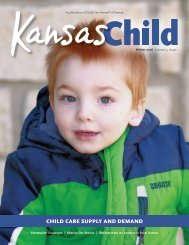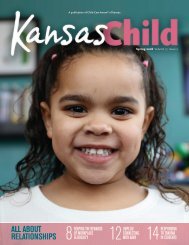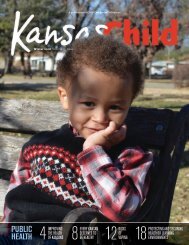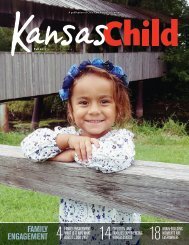2019 Winter Kansas Child
Kindergarten Readiness
Kindergarten Readiness
- No tags were found...
You also want an ePaper? Increase the reach of your titles
YUMPU automatically turns print PDFs into web optimized ePapers that Google loves.
Continued from page 5<br />
The future for all children is brighter<br />
when schools and communities<br />
prioritize early learning and engage<br />
families long before children start school.<br />
Empowering parents and caregivers to<br />
help nurture a child’s development from<br />
birth through third grade considerably<br />
increases the child’s potential to learn<br />
and enjoy school year after school year.<br />
Reading is Essential for Learning<br />
Although children in all cultures<br />
instinctively learn language from their<br />
parents and caregivers, the brain must be<br />
taught to read.<br />
The <strong>Child</strong>ren’s Reading Foundation®<br />
encourages parents and caregivers to<br />
Read Together 20 Minutes Every Day<br />
with their children, starting at infancy.<br />
When children are exposed to the<br />
language in books, they are developing<br />
significant brain connections for language<br />
development and for learning to read<br />
when the time comes. <strong>Child</strong>ren are also<br />
learning sounds, vocabulary, prereading<br />
and multiple skills that will be reinforced<br />
day after day at home and school.<br />
Both educators and the medical<br />
community recognize the vital importance<br />
for all children to be exposed to books. The<br />
American Academy of Pediatrics states:<br />
Reading regularly with young children<br />
stimulates optimal patterns of brain<br />
development and strengthens parentchild<br />
relationships at a critical time in<br />
child development, which, in turn, builds<br />
language, literacy and social-emotional<br />
skills that last a lifetime.<br />
90% Reading Goal<br />
From kindergarten through third<br />
grade, children are learning to read;<br />
after third grade students are reading to<br />
learn. Although reading is paramount to<br />
learning, about 75 percent of struggling<br />
readers in third grade won’t catch up to<br />
their classmates.<br />
To help reverse this trend, the Reading<br />
Foundation encourages school districts<br />
and communities to adopt a 90% Reading<br />
Goal. This means 90 percent of thirdgraders<br />
will read at or above grade level by<br />
the end of the school year. The goal is not<br />
easy, but it can be done with a long-term,<br />
committed effort.<br />
The 90% Reading Goal is how The<br />
<strong>Child</strong>ren’s Reading Foundation was<br />
formed. In 1996, a group of community<br />
stakeholders with the Kennewick School<br />
District in Washington state came together<br />
to increase reading skills districtwide and<br />
set this goal. At the time, only 55 percent<br />
of the district’s third-graders were<br />
reading at grade level.<br />
Our Read Together<br />
Read with your<br />
child for 20 minutes<br />
every day; five minutes<br />
now, five later and 10<br />
at bedtime.<br />
20 Minutes Every Day<br />
message was spread<br />
far and wide and<br />
reinforced in local<br />
media interviews,<br />
public service messages,<br />
employee newsletters,<br />
community presentations,<br />
libraries, bookstores,<br />
professional organizations and by<br />
business leaders throughout the area.<br />
As a result, reading scores improved.<br />
However, it became clear that unless the<br />
district engaged parents and child care<br />
providers during children’s powerful<br />
early learning years the district would be<br />
perpetually reacting to the new wave of<br />
entering kindergartners — 40 percent with<br />
readiness skills one to three years below<br />
grade level. The solution was READY! for<br />
Kindergarten, a program of The <strong>Child</strong>ren’s<br />
Reading Foundation.<br />
After implementing the READY!<br />
program, the reading achievement scores<br />
of Kennewick School District students<br />
increased substantially. Nine of 13<br />
Kennewick elementary schools reached<br />
the 90 percent goal by 2003, and the goal<br />
was achieved districtwide in 2006. The<br />
district continues to offer free READY!<br />
workshops to parents within its district,<br />
and throughout the years reading levels<br />
have remained near 90 percent.<br />
The READY! for Kindergarten approach<br />
encourages parents to read with their child<br />
20 minutes every day and Play With a<br />
Purpose for 10 minutes each day. Through<br />
a series of annual parent workshops, offered<br />
in English or Spanish, participants explore<br />
how to create a home environment where<br />
learning happens in a fun and purposeful<br />
way. The READY! Age Level Targets ©<br />
are the framework for developmentally<br />
appropriate lessons and activities using<br />
take-home materials and tools that help<br />
develop skills commonly associated with<br />
school readiness in three domains: language<br />
and literacy, math and reasoning, and social<br />
and emotional development.<br />
What You Can Do<br />
Parents and caregivers: You are your<br />
child’s first teacher. Read with your child<br />
for 20 minutes every day; five minutes<br />
now, five later and 10 at bedtime. No<br />
matter their age, when you spend 20<br />
minutes every day reading, children<br />
are learning.<br />
You don’t have to be a<br />
good reader to help nurture<br />
literacy skills in children. The<br />
most important thing is the<br />
time spent together around<br />
books — even wordless<br />
books — where stories are<br />
made up, and each time the<br />
book is opened a new story is told.<br />
Having a two-way interaction while<br />
reading not only strengthens the child’s<br />
prereading skills, it also develops solid<br />
foundations for critical thinking.<br />
Sharing a book with a child has<br />
significant additional benefits. Reading<br />
together develops socially and emotionally<br />
confident children who have strong<br />
bonds. It also empowers parents and<br />
caregivers to become their child’s first<br />
and most influential teachers. If that isn’t<br />
enough, reading with a child also reduces<br />
the school readiness gap and lowers<br />
remediation expenses by helping children<br />
start and stay at grade level.<br />
If you are a parent of a newborn to<br />
5-year-old and are in a community that<br />
offers READY! for Kindergarten parent<br />
workshops — attend. You will learn the<br />
readiness skills that will prepare your child<br />
for a successful and enjoyable kindergarten<br />
experience. You will also leave with new<br />
ideas about how to guide your child’s<br />
language and literacy, math and reasoning,<br />
and social and emotional learning,<br />
with respect to their individual stage of<br />
development.<br />
Schools, child care and preschool<br />
programs, foundations, community<br />
organizations: You are the direct link to<br />
parents. Invest in early learning to help<br />
close the readiness gap. This focus on<br />
children before they start school will also<br />
engage families in their essential role in<br />
raising a reader and getting their child<br />
ready for kindergarten.<br />
It will take all of us to ensure every<br />
child starts school prepared and eager to<br />
continue learning to reach his or her full<br />
potential in school and life. n<br />
6 <strong>Kansas</strong> <strong>Child</strong> A Publication of <strong>Child</strong> Care Aware ® of <strong>Kansas</strong>
















